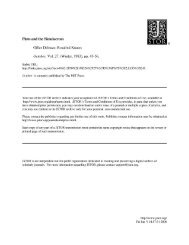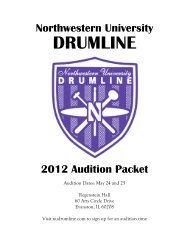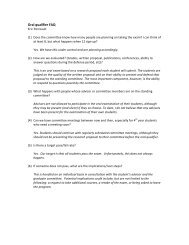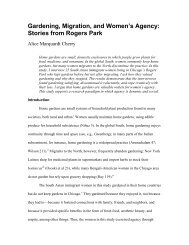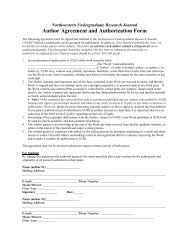RESEARCHwas air/ And playing, lovely and watery/ And fire greenas grass” (19-22). Indeed the speaker’s description of thenatural scene around him does seem to be “running.”He describes the different components of the scene,such as the sun, hay fields, and air through enjambedstaccato verses of primarily monosyllabic syllables, anduses the connective “and” frequently to link verses, asopposed to adopting more marked pauses (i.e. a comma,semicolon, or period).As the poem progresses, symbolizing the passageof time, Thomas’s tone shifts drastically. In retrospect,Thomas’s speaker realizes death’s presence and duplicity,as he writes, “Time let me play and be/ Golden in themercy of his means” (13-14). Although death disguiseditself through a seemingly generous time that granted“mercy” during his youth, Thomas is now fully awarethat the mercy was only temporary, for every day of hismajestic youth moved him one step closer to death:And nothing I cared, at my sky blue trades, that time allowsIn all his tuneful turning so few and such morning songsBefore the children green and goldenFollow him out of grace.Nothing I cared in the lamb white days, that time would take meUp to the swallow thronged loft by the shadow of my hand,In the moon that is always rising,Nor that I riding to sleepI should hear him fly with the high fieldsAnd wake to the farm forever fled from the childless land. (42-51, emphasis added)The scene portrayed here epitomizes Thomas’s realizationof the ominous nature of death. His discovery offalling “out of grace” is incredibly disturbing and exemplifieshis conception of death as a merciless “destroyer.”The speaker’s portrayal of death verges on that of aseductress, leading him unknowingly to the “swallowthronged loft.” Alas, the days of his youth have passed alltoo quickly, and the speaker now finds himself trappedin the grudgingly lonely days of adulthood.The speaker at this point is now an old man, anxiouslyawaiting death. Though death managed to foolhim during his younger days, he is now fully aware oflife’s paradoxical nature: “Oh as I was young and easyin the mercy of his means, / Time held me green anddying/ Though I sang in my chains like the sea” (52-54).The speaker acknowledges the limitations that time imposesbecause he perceives death as a fixed and absoluteend. Though time once held him “green,” he realizesnow that it simultaneously holds him “dying,” for itsprogression moves incessantly toward the end of humanexistence.Romantic writers, though expressing a similar lamentin response to the initial pain of death, neverthelessfelt themselves able to transcend the boundaries ofmortality. The speaker in “A Slumber Did My Spirit Seal”observes that through the young girl’s unity with EternalNature, she in effect becomes eternal herself. Shelley’sspeaker remarks that Keats’s death actually brings abouta more-elevated form of existence through his being rememberedby countless generations thereafter. Thomas,however, resists all such reappraisal. At the end of hispoem, though he finds himself “singing,” fighting withall of his might against inevitable death, he admits thathe is ultimately in “chains,” forever bound to the fixedmaterial fate that time has given him.5. ConclusionAlthough modern criticism regularly analyzesThomas’s work relative to the inspiration he drew fromthe Romantics, such analysis overlooks many of thesubtle revisions he made to that paradigm. The similarities,marked most saliently by a shared curiosity aboutthe relation between the mind and natural world, andbetween Thomas, Shelley, and Wordsworth, can hardlybe doubted. Nevertheless, when examining the poetryof these poets through the lens of death, Thomas clearlydistinguishes himself from those that came before him.Both Wordsworth and Shelley were able to mitigatetheir sorrow by reappraising death—by assigning italternate meaning not limited to an absolute or finiteending to human experience. Rather, they were able toconstrue it as a path to spiritual transcendence, as a positiveforce that, albeit ending life, opens up a new realmof existence that should be revered—“where the eternalare,” as Shelley claims eloquently in Adonais.Thomas, by contrast, never attained that consolationor sense of reassurance in his poetry; he held oninstead to anxiety, angst, and his many qualms aboutdeath. Although Thomas repeatedly sought the solacethat Wordsworth and Shelley attained their poetry, ultimatelyhe could never break free of his preoccupationwith death, the formidable “chains” of a material understandingof human existence.Works CitedAbrams, M. H. Natural Supernaturalism. New York: Norton & Company, Inc., 1971.Bate, Jonathan. “Living with the Weather.” Studies in Romanticism 35.3 (1996): 431-47.Ferguson, Margaret, Mary Jo Salter, and Jon Stallworthy, eds. TheNorton Anthology of Poetry. New York: Norton, 2005.Hulme, T. E. “Romanticism and Classicism.” Speculations: Essays on Humanism and thePhilosophy of Art. Ed. Herbert Read. London: KeganPaul, Trench, Trubner, 1936. 113-40.Ramazani, Jahan. Yeats and the Poetry of Death: Elegy, Self-Elegy,andthe Sublime. New Haven: Yale <strong>University</strong> Press, 1990.Shelley, Percy Bysshe. Adonais. The Norton Anthology of Poetry. 879-91.Thomas, Dylan. “Fern Hill.” The Norton Anthology of Poetry. 1571.Wordsworth, William. “A Slumber Did My Spirit Seal.” The Norton Anthology of Poetry. 790.32 NORTHWESTERN UNDERGRADUATE RESEARCH JOURNAL
RESEARCHSOUTHWESTTO THE RESCUE?An Investigation of Hub Premiums and Southwest AirlinesUsing a regression study of data comparing 2000 and 2010, this studyinvestigates the effect of Southwest Airlines on the pricing strategy ofthe legacy air carriers (American, Continental, Delta, Northwest, USAirways, and United). Namely, it looks into if Southwest has curbedthe ability of the legacy carriers to command a “hub premium” bycharging higher prices for flights originating or terminating at theirrespective hub airports. Test results show that the hub premiums ofthe legacy carriers were large and significant in 2000 but had declinedby 2010. However, the declines cannot be clearly attributed to thepresence of Southwest Airlines at the legacy carriers’ respective hubairports. In fact, a Southwest presence seems to matter less in 2010than in 2000. The <strong>research</strong> also examines whether Southwest Airlinesextracts hub premiums of its own. Empirical evidence suggests thatSouthwest charges higher prices not only for its flights with an origin ordestination at airports where it has its largest operations but also for itsflights originating or ending at one of the legacy carrier hub airports.Suzanne ChangDEPARTMENT OF ECONOMICSRobert GordonFACULTY ADVISORDEPARTMENT OF ECONOMICSSteffen HabermalzSECONDARY ADVISORDEPARTMENT OF ECONOMICSI. IntroductionSince the US Airline Deregulation Act of 1978, six legacy carriers, American, Continental, Delta, Northwest,US Airways, and United, and several strong low-cost carriers, notably Southwest, eventually emerged after a longsuccession of mergers and bankruptcies. The legacy airlines began in 1978 with a mix of hub operations and pointto-pointlinear routes between cities other than their hubs; gradually over time the linear routes were dropped andairlines centralized operations at a few hub airports serving a wide variety of destination or “spoke” airports. As a result,the notion of a “hub premium” has been popularized in airline pricing studies to capture a difference in air faresbetween flights originating or terminating at a hub airport and those that do not take off or land at a hub.Research on hub premiums has focused on either identifying the existence of hub premiums or attributing possiblecauses to the presumably existing premiums. Borenstein (1989) concludes that an airline’s dominance at hubairports leads to higher fares for passengers traveling to or from these airports. Lederman (2008) finds that both ahub premium and frequent flier program partnerships allow airlines to charge higher fares for flights that originatedfrom places where their FFP partner was dominant.Berry, Carnall, and Siller (1996) attribute most of the hub premium to business travelers, who are more priceinelasticthan non-business travelers, an assertion further supported by Lee and Luengo-Prado (2005). In contrast, a2001 U.S. Department of Transportation study is highly critical of the position that the higher fares can be ascribedto passenger mix, despite its finding of a premium on prices at hub airports. It instead attributes the premium to airlinesnot meeting passenger demand for lower-fare seats in their hub markets. In short, while past studies agree onthe existence of a hub premium, they do not necessarily agree on the driving forces behind the premium.Adding to the disagreement in <strong>research</strong> findings, Gordon and Jenkins (1999) actually document a hub discountwith passengers on flights with an origin or destination at one of Northwest’s three hubs, Detroit, Memphis, andMinneapolis, paying fares about four percent less than passengers with an origin or destination elsewhere in Northwest’snetwork.Although Southwest’s operations first focused on smaller markets and at airports not dominated by the legacyVOLUME 7, 2011-2012NORTHWESTERN UNDERGRADUATE RESEARCH JOURNAL33




